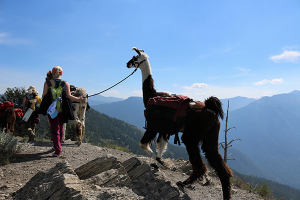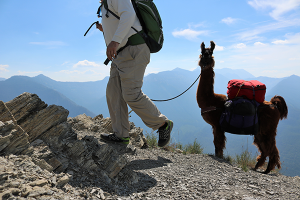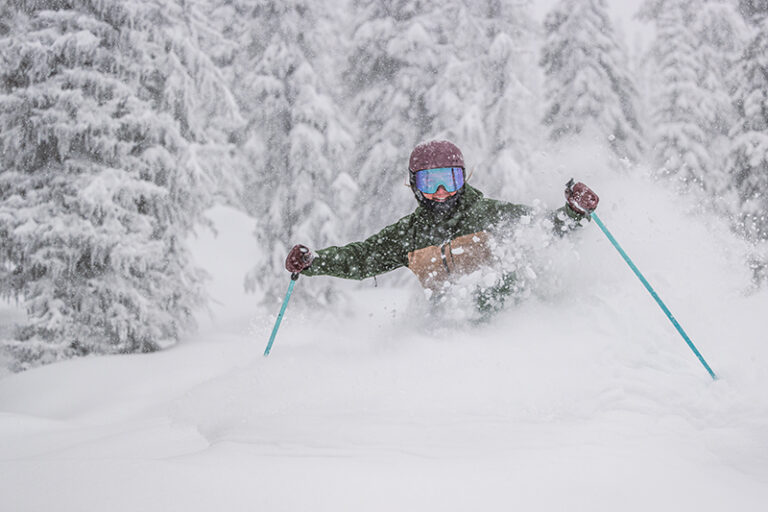Four-legged friends are the best hiking buddies—particularly when they carry the wine, hum sweet-nothings in your ear, and provide protection while trekking in the Wild West. Llamas tell an ancient story through their legacy careers as backcountry packers, granting humans assistance with economic livelihood and recreational pursuits. They are also intriguing with their comical appearance, quirky personalities, and superhero abilities to survive in some of the world’s most rugged terrain. This camelid species has my attention as an entertaining hiking companion, and it possesses the unexpected qualities of a great backcountry partner.
An Andes mountain native and a relative to the camel, llamas are born with ample genetics to easily get them through days of hiking in the Rocky Mountains. As low-maintenance as they are sure-footed, steep and rocky terrain is no match for these “camels of the clouds.” They began their packing-for-humans career about 5,000 years ago and were bred to carry the weight of early goods over the high mountain passes of South America. Some of the earliest llama packers helped to connect communities of people through commerce and trade. In modern days, they continue packing for people who simply want to connect with pristine backcountry places.
I’ve always considered my dog as the best hiking companion (sorry husband) but pondered alternatives when introduced to llamas. Apparently, llama trekking is a known practice that I’d never considered before taking a trip with Swan Mountain Llama Trekking. When first hired by an outfitter to promote Montana horseback riding and fishing, I chuckled when the llama brochure appeared. I wondered: do you ride the llama? Do they spit on people? And, how could a hike possibly be fun with a pack animal?

The first thing I discovered is that guides assist a lot when hiking with a llama trekking outfit. Getting ready for an overnight trip requires efficiency. They place gear into specialty packs, taking care to evenly distribute weight, and eventually attach packs to the backs of the lovely assistants. And there’s more good news: hiking with wine and fishing gear just got easy with this backcountry assist. Llamas can carry about 20% of their body weight, packing loads of 60 to 80 pounds for multi-day trips. That’s a lot of wine.
When finally packed, hikers take a lead rope while the llama follows alongside, traveling at about a 2 mile-an-hour pace. They occasionally jump on and off the trail, which can be alarming at first, but their unearthly heightened awareness keeps the animal from running over people. Though the trek is an ultra-light experience for the hiker, it is not a desired pace for an ultra-light trail runner. There’s definitely a time and place for this unique venture. Llama treks bring out smiles on family trips and groups that don’t want to carry backpacking weight yet seek the experience to get away from it all. And no, llamas don’t spit on people, though they might occasionally spit at other llamas when provoked.
At times llamas behave strangely, as if they’re aliens living on earth. They occasionally let out a throaty hum to communicate, and other animal species quickly shy away from the creature when encountered on the trail. Horses don’t appreciate the llama’s extraterrestrial appearance, and wildlife such as bear and coyote will keep their distance. Llamas are extremely alert, responding to new intruders by approaching with curiosity and intent; it’s why they are used on farms to protect agricultural herds from potential predators. This behavior is reassuring when recreating in Montana’s bear country. In fact, guides will tie-up llamas around trail-food storage to protect snacks from hungry critters of the night.

Llamas also embody amazing attributes; their camel genetics make the species incredibly low-maintenance for backcountry travel. They graze on leaves and twigs while hiking and rarely need to stop to eat. Additionally, llamas are excellent for both hiking and backcountry hunting, as they can go without drinking water for up to three days. These packer friends can be tied safely to a tree and left alone for a couple of days before the hunter returns to retrieve the llamas, who then assist with packing out harvested game.
No, I could never replace my best canine hiking buddy of 10 years; dogs are much more affectionate than llamas. However, the llama herbivore is one-with nature and won’t compete with your treasured piece of cheese; their prehensile lips are too busy grasping every stick in sight. And perhaps their agile lips can be trained to hold-up a bag of wine for a thirsty camper. Oh, the trail dreams that surface when spending days in the woods telecommunicating with a pack animal. Maybe backcountry travel is better with a llama! For more information on backcountry llama trekking in Montana, check out Llamatreksmontana.com. //
Katie LeBlanc wrote about trail running in Glacier National Park in June.













